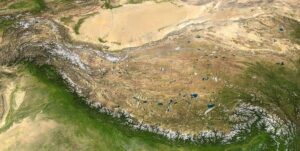
AMERICAN ASSOCIATION FOR THE ADVANCEMENT OF SCIENCE (AAAS)—Researchers have characterized the DNA of 89 ancient individuals from the Tibetan Plateau, some of whom lived as early as about 5,100 years ago, revealing population differences across time and space that helped to shape the unique gene pool of present-day Tibetans. The ancestry of the Tibetan Plateau is of interest to many researchers, including those seeking to understand the origins of many Tibetans’ genetic adaptations to the plateau’s harsh environments and high altitudes. One example is the EPAS1 allele carried by many Tibetans, which is likely an adaptation to lower oxygen levels found at high elevation and is thought to have originated from archaic humans known as Denisovans. This study* shows that frequencies of the EPAS1 allele increased over about the last 2,800 years on the Tibetan Plateau, with an especially sharp increase over about the past 700 years. Recent studies have explored the shared ancestry between present-day Tibetans and ancient Tibetans who lived along the Himalayan arc near Nepal as early as 3,400 years ago, but these analyses were limited in geographic and temporal scope. Now, Hongru Wang and colleagues have analyzed DNA from the remains of 89 ancient Tibetan individuals dating from about 5,100 to 100 years ago at 29 sites across the Tibetan Plateau. They identified stark genetic differences between populations occupying the northeastern, southeastern, and southern regions of the plateau as recently as about 2,500 years ago. Subsequent genetic shifts suggest that human migrations and interactions within and between highland and lowland populations may have influenced genetic mixing over time. “We show that the unique ancestry in present-day plateau populations can be found in ancient individuals across the entire Tibetan Plateau, extending as far back as 5,100 [years before present],” Wang et al. write. “The largest genetic shifts are caused by the mixture of populations from different regions of the plateau, potentially associated with large-scale political shifts related to the expansion and collapse of major state-level societies in historical times.”
______________________________

Tibetan Plateau composite image from NASA photos. Public Domain, Wikimedia Commons
______________________________
Article Source: AMERICAN ASSOCIATION FOR THE ADVANCEMENT OF SCIENCE (AAAS) news release.
*Human genetic history on the Tibetan Plateau in the last 5,100 years, Science Advances, 17-Mar-2023. 10.1126/sciadv.add5582
______________________________
Advertisement
______________________________

Don’t miss out on this unforgettable evening as Dr. Hawass reveals the most closely guarded secrets of ancient Egypt and presents his groundbreaking new discoveries and latest research live on stage. As the man behind all major discoveries in Egypt over the last few decades and director of several ongoing archaeological projects, Dr. Hawass may yet surprise you with unexpected revelations that will make news across the world.
______________________________




